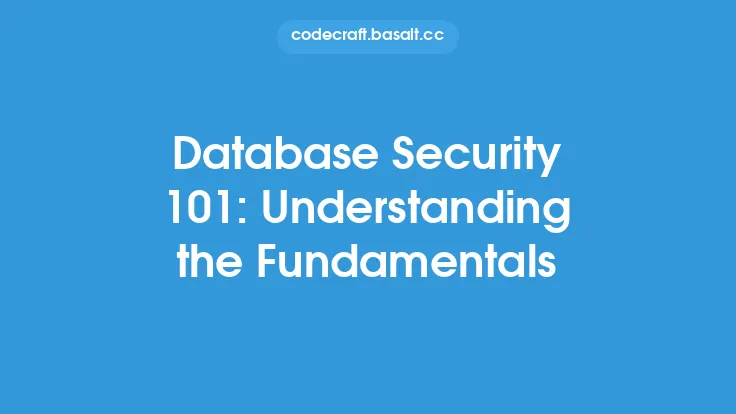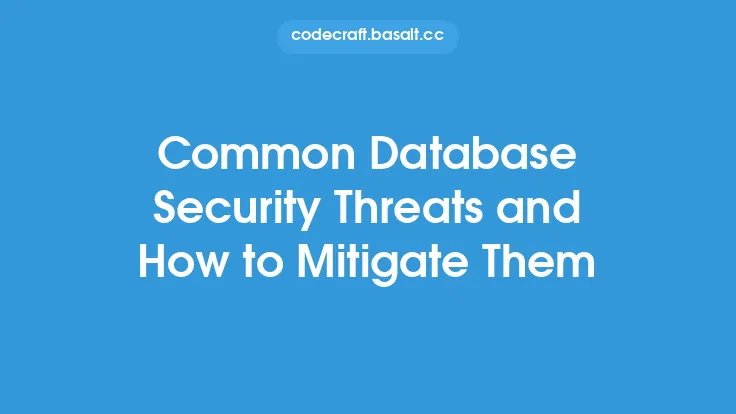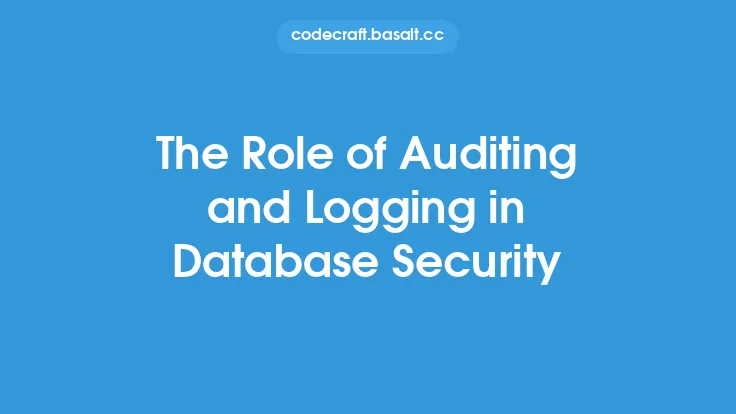Developing and implementing robust database security policies and procedures is crucial for protecting sensitive data and preventing unauthorized access. As a developer, it is essential to understand the importance of database security and the measures that can be taken to ensure the confidentiality, integrity, and availability of data. In this article, we will delve into the key aspects of database security policies and procedures, providing developers with a comprehensive guide to securing their databases.
Introduction to Database Security Policies
Database security policies are a set of rules and guidelines that outline the measures to be taken to protect a database from unauthorized access, use, disclosure, disruption, modification, or destruction. These policies are designed to ensure the confidentiality, integrity, and availability of data, and are typically developed and implemented by an organization's IT department or database administration team. A well-defined database security policy should include procedures for access control, authentication, authorization, data encryption, backup and recovery, and auditing and logging.
Developing Database Security Procedures
Developing database security procedures involves identifying the potential risks and threats to the database, and implementing measures to mitigate or eliminate them. This includes conducting regular security audits and risk assessments, implementing access control and authentication mechanisms, and developing procedures for incident response and disaster recovery. Database security procedures should also include guidelines for data encryption, backup and recovery, and auditing and logging. Additionally, procedures should be established for managing database user accounts, including account creation, modification, and deletion.
Access Control and Authentication Procedures
Access control and authentication procedures are critical components of database security. These procedures ensure that only authorized users have access to the database, and that their actions are tracked and monitored. Access control procedures should include guidelines for creating and managing user accounts, assigning privileges and roles, and controlling access to sensitive data. Authentication procedures should include guidelines for password management, multi-factor authentication, and secure communication protocols. Developers should also consider implementing row-level security and dynamic data masking to further restrict access to sensitive data.
Data Encryption Procedures
Data encryption procedures are essential for protecting sensitive data both in transit and at rest. These procedures should include guidelines for encrypting data using secure encryption algorithms, such as AES or RSA, and for managing encryption keys. Developers should also consider implementing transparent data encryption, which automatically encrypts and decrypts data without requiring changes to applications. Additionally, procedures should be established for encrypting data in motion, such as when data is being transmitted over a network.
Backup and Recovery Procedures
Backup and recovery procedures are critical for ensuring the availability of data in the event of a disaster or data loss. These procedures should include guidelines for creating backups, storing backups, and recovering data from backups. Developers should also consider implementing incremental backups, which backup only the data that has changed since the last backup, and differential backups, which backup all the data that has changed since the last full backup. Additionally, procedures should be established for testing backups and ensuring that they can be recovered in a timely manner.
Auditing and Logging Procedures
Auditing and logging procedures are essential for tracking and monitoring database activity, and for detecting and responding to security incidents. These procedures should include guidelines for configuring audit logs, monitoring audit logs, and responding to security incidents. Developers should also consider implementing real-time auditing and logging, which provides immediate notification of security incidents, and automated logging, which reduces the administrative burden of logging and auditing.
Incident Response and Disaster Recovery Procedures
Incident response and disaster recovery procedures are critical for responding to security incidents and disasters, and for minimizing the impact on the database and its users. These procedures should include guidelines for responding to security incidents, such as data breaches or unauthorized access, and for recovering from disasters, such as natural disasters or system failures. Developers should also consider implementing incident response plans, which outline the steps to be taken in response to a security incident, and disaster recovery plans, which outline the steps to be taken to recover from a disaster.
Compliance and Regulatory Requirements
Compliance and regulatory requirements are essential for ensuring that database security policies and procedures meet the requirements of relevant laws and regulations. Developers should be aware of the compliance and regulatory requirements that apply to their organization, such as HIPAA, PCI-DSS, or GDPR, and ensure that their database security policies and procedures meet these requirements. This includes implementing procedures for data protection, access control, and auditing and logging, and ensuring that these procedures are regularly reviewed and updated to ensure compliance.
Best Practices for Database Security
Best practices for database security include implementing robust access control and authentication mechanisms, encrypting sensitive data, regularly backing up data, and monitoring audit logs for security incidents. Developers should also consider implementing secure coding practices, such as input validation and error handling, and regularly testing and evaluating database security. Additionally, best practices include implementing a defense-in-depth approach, which involves implementing multiple layers of security controls to protect the database, and regularly reviewing and updating database security policies and procedures to ensure they remain effective.
Conclusion
In conclusion, developing and implementing robust database security policies and procedures is crucial for protecting sensitive data and preventing unauthorized access. By following the guidelines and best practices outlined in this article, developers can ensure the confidentiality, integrity, and availability of data, and minimize the risk of security incidents and data breaches. Remember, database security is an ongoing process that requires regular review and updating to ensure the security and integrity of the database. By prioritizing database security and implementing robust policies and procedures, developers can help protect their organization's sensitive data and maintain the trust of their users.





